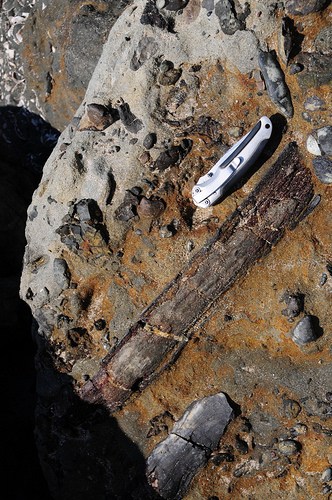- Whale Skeleton bones
- Macoma sp. Shells
More information on fossils in Capitola, CA: link here
More information on fossils in Capitola, CA: link here
Geology: Being within the Santa Cruz Mountains in the Central Coast Ranges, Scotts Valley is a geologically active region under the influence of multiple fault lines. The valley’s bedrock is part of the Purisima Formation. Fossils obtained in the area are likely part of the Santa Margarita Sandstone. According to the Scotts Valley Town Center, “The Santa Margarita Sandstone generally consists of massive, fine- to medium-grained sandstone of upper Miocene geologic age. The Santa Margarita Sandstone forms a distinctive formation of white and yellow sand that can be observed in cliffs around the area”.
Paleontology: Marine fossils are very prevalent in the area, and it is a common area for fossil collectors to visit. Shark teeth (Mako, Megalodon, etc), dolphin, whale, sea cow, and walrus bones, and sand dollars have been found in the area. Sand dollars are especially common and should be fairly easy to spot. Here is a collection of photos of fossils recovered from the area from the Land Trust of Santa Cruz County. Recently, a four million year old whale fossil was discovered in the area. The find was covered by the article, “Whale Fossil Uncovered in Scotts Valley”.
Directions to Sand Dollar Site: One site in particular is known for its abundance of sand dollars. According to this fossil collector, Take Hwy 17 south from San Jose towards Santa Cruz/Scotts Valley. Take Mount Hermon Exit in Scotts Valley. Turn right onto Scotts Valley Drive. Turn right onto Bean Creek Road, and drive a little over a mile until you see a tall, sandy roadcut that is fairly steep. However, it is important that the area is off limits, and you will encounter ‘No Trespassing’ signs.
Works Cited:
RMcWilson, “Fossil Sand Dollar Site in Scotts Valley, California,” (Flickr 2009)
“Scotts Valley Town Center Specific Plan EIR, 4.5 Geology and Soils,” (City of Scotts Valley) http://www.scottsvalley.org/downloads/town_center/4.5%20Geology%20and%20Soils.pdf
Geology of the Beach:
The yellow brown sandstones that contain the fossils are part of the Purisma formation. Collecting is best at low tide, when the outcroppings are most exposed. 
Paleontology of the Fossils:
The fossils originate from the Pliocene epoch of the Neogene period. Bivalves, gastropods, sea urchins, crabs, marine mammal bones from whales and seals can be found. Shark teeth have also been recovered from the beach, but are rare.
An extensive photo gallery of the fossils common at Capitola Beach can be found here: http://nextcenturyimages.com/nature/capitolafossils2307/index.html
Works Cited:
“CA Capitola,” (Paleontica Fossiel August 2012) <http://english.fossiel.net/sites/fossil_site.php?plaats=506>